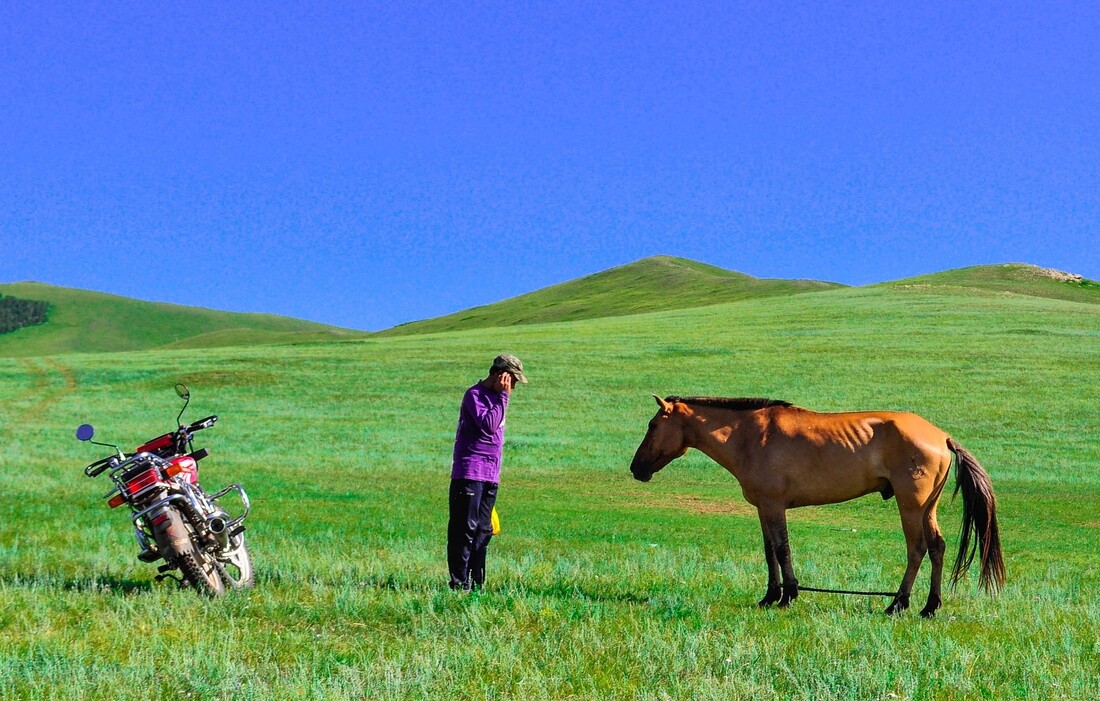|
‘I’m not in your situation. And neither am I you in your situation.’ (David Cooper) A stretching skill in coaching, action learning and facilitation is often to step back and to stay back. I may imagine vividly what I might think, how I might feel and what I might do if I were in the situation a client has described. Nevertheless, as David Cooper has summarised so well (above), the truth is I’m not there and I’m not you. A risk is that I may inadvertently and subconsciously project myself onto the world of the client. Why is this important and how can we use it? Firstly, the client portrays a challenge, dilemma or opportunity from their own perspective. It’s a personally and-or socially-constructed view with associated feelings that may reveal all kinds of hidden assumptions, beliefs, values, hopes and expectations. These may be quite different to what the same situation could hold for the coach. Exploring how the client construes the situation and what lays behind and beneath it for them can unlock fresh insight and potential. Secondly, factors that stand out to the client as significant in a situation can be very different to those that stand out for the coach because of differences in what people notice, what value they attach to it and what meaning they make of it. What a person notices is influenced psychologically by what’s important to them. What, therefore, surfaces into awareness (or not) for the client can shed useful light on underlying personal-cultural assumptions, beliefs and values. Thirdly, how the coach could act in the client’s situation - and the consequences of their actions - would be influenced by their own lived experiences, their personal preferences and cultural norms, their own networks of relationships and the knowledge and skills they can draw upon. Unless the client’s issue has a definitive right or correct solution, the optimal way through for the client may be quite different to that for the coach. I’m not in your situation – and I’m not you.
18 Comments
Picture this. Here I am in a church meeting when a woman sitting in front of me starts to shake physically. This was in the context of a meeting where expectations were high that God would do something dramatic. The people around this woman prayed enthusiastically and the physical shakes were interpreted as a visible and positive sign of God’s activity.
I later spoke to a nurse and asked how the same phenomenon would be interpreted in, say, an Accident & Emergency unit at the local hospital. ‘Possibly as some kind of neurological disturbance’, she replied. I then asked how medical staff were likely to respond if they observed this happening. ‘They would probably conduct tests to understand and treat the underlying physical cause.’ This intrigued me. It’s as if the interpretation we apply to an experience depends partly on the socio-physical environment in which the phenomenon arises (in this example, a church or hospital) and what the prevailing expectations and interpretations are in that context. It also depends on our own personal belief systems and the broader cultural worldview that we inhabit. This raises interesting questions about which, if either, interpretation is ‘correct’. Someone of a particular religious conviction may argue strongly for a spiritual interpretation whereas someone of a secular-medical outlook may argue equally strongly for a medical interpretation. It sets up the risk of a false dichotomy, as if different interpretations are necessarily mutually exclusive. One way to look at this is that events and experiences have no inherent meaning of their own. They just are what they are. What happens simply…happens. As individuals and social groups (e.g. cultures, professions), we construct meaning based on what we believe and hold to be true. In other words, we apply meaning to events and experiences rather than derive meaning from them. A non-medical church member may look at the experience through a spiritual lens; a secular medical practitioner through a scientific lens. As a consequence, they each notice, don’t notice, include and conclude something different. Each lens creates and reinforces its own meaning, superimposes its own meaning, and, having done so, appears obvious or self-evident for those share that view. It seems possible to me that the same phenomenon can carry more than one meaning. In the example above, it’s possible (assuming, as I do, that God exists) that God may act in a person’s life by creating a neurological disturbance that may, say, reveal some hidden issue psychosomatically or symbolically that is important for that person or cultural community to pay attention to. Having said that, there may be different explanations altogether to those offered above that could explain this experience. They may not be obvious to us because they don’t fit with our current frames of reference or lenses and are, therefore, in effect, invisible to us. It’s a bit like asking a colour-blind person to describe coloured images or shapes on a card that lie outside their ability to perceive. So what is the significance for leadership, coaching and facilitation? I think it’s something about being aware, as far as we can be, of our own personal and cultural influences, the effect they have on, say, who and what we notice and don’t notice, who and what we value and don’t value and the impact we have on others. It’s about being willing to engage in the existential struggle that holding core assumptions lightly whilst taking a stance with conviction entails. It’s about using our work to help others – whether individuals, teams or organisations – grow in awareness of their personal and cultural beliefs, values and assumptions so they can explore new possibilities constructively and creatively. It’s about modelling and nurturing curiosity, integrity and hope. Why think outside of the box when you could dispense with the box altogether? Rosabeth Moss-Kanter commented recently on Twitter that ‘To lead real change, it’s not enough to think outside of the box. We need to think outside of the building.’ It reminded me of Chris Argyris who, some years ago, coined the phrase ‘learning loops’ to describe different levels of learning and application:
Single loop learning asks the question, ‘Are we doing this right?’, e.g. ‘Do we have a clear agenda for today’s meeting?’ Double loop learning steps back to ask, ‘Are we doing the right things?’, e.g. ‘Is a meeting really the best way to do this?’ Triple loop learning steps back further still to ask, ‘How do we decide what is right?’, e.g. ‘Are we focusing our attention on the most important things?’ Each step back brings new dimensions into the frame, surfacing and thereby opening assumptions to challenge. I think of it like concentric circles, ripples on a pond, ever moving outwards from the initial point of impact or concern. It exposes wider systems. It shifts the focus onto broader cultural or contextual issues in order to make sense of and take decisions within a narrower domain. There are some parallels with strategic, tactical and operational lenses, aimed at ensuring effectiveness. Peter Drucker commented: ‘Nothing is less productive than to make more efficient what should not be done at all.’ How much resource do we waste in organisations inadvertently paying one person or team to burn the proverbial toast and another to scrape off the burnt bits? So we are really looking at how to ask fundamental questions. ‘What is the purpose of our organisation in the world?’ I mean existentially or spiritually, not just pragmatically. 'Why are we here?', ‘What is shaping our values?’, ‘What are we aware of?’, ‘What are we blind to, filtering out?’, ‘What matters most to us, and why?’, ‘Why are we doing things this way?’, ‘Who or what is really driving this?’ This type of critique is where things get tricky and, potentially, revolutionary. Organisations, as people, shape their own perception of reality, what is real and what is true, by the way they construe situations, the narratives they create to explain their experiences, the rationalisations they use to justify their actions etc. And most of this is subconscious, hidden behind cultural filters and defences. Deconstructing the box entails a willingness to acknowledge it first – to explore and reveal the unspoken, the unspeakable, the not-yet imagined. As leaders and coaches, it calls for vulnerability and courage. It demands a preparedness to challenge and be challenged, to open our eyes, perhaps pray, to expose our limits, our assumptions, our implicit collusion with what is and what appears to be. What is real, what is true, how can we know? These are questions that have vexed philosophers for centuries. In more recent times, we have seen an increasing convergence between philosophy and psychology in fields such as social constructionism and existential therapy. How we experience and make sense of being, meaning and purpose is inextricably linked to how we behave, what we choose and what stance we take in the world. As a Christian and psychological coach, I’m intrigued by how these fundamental issues, perspectives and actions intertwine with my beliefs, spirituality and practice. Descartes once wrote, ‘If you would be a real seeker after truth, you must at least once in your life doubt, as far as possible, all things.’ It’s as if we must be prepared to suspend all assumptions about ‘what is’, to explore all possibilities and dare to think the unthinkable in order to grow and make our best contribution. Things are not always as they at first appear. There are sometimes multiple explanations for the same phenomenon, depending on the frame of reference we or others use to interpret it (see, for instance, Gareth Morgan’s seminal work, Images of Organisation, 1986). We are sometimes blinded to what’s in front of us by our prejudices, preconceptions, cultural constraints or rigid views of the world. It can be hard to maintain healthy scepticism without cynicism. I see it with clients, sometimes in myself too. A sense of being trapped by a fixed Gestalt, a cognitive distortion, an inherited or learned belief system. An inability to see, to recognise the box that we’re in, never mind to see or think outside of it. An avoidance of deep, difficult questions because of the discomfort, confusion or anxiety they may evoke. If we’re not careful, if we can’t find the right help when we need it, it may limit our lives and our learning. I think this is where coaching can play a very important role, helping pose and address some deep questions. Nick Bolton commented insightfully in Coaching Today that, ‘To explore a coaching issue existentially is to understand the relationship that the presenting problem has to the human condition to which it is a response, and to remain focused on enabling a change of perspective that allows the client to move past their current challenge.’ He also provided some helpful examples: ‘For instance, how is a client’s procrastination around something that seems to matter to her a failure to remember that life comes to an end? How is a client’s need to be unconditionally loved by his partner an attempt to deal with existential rather than interpersonal isolation? (And the solutions are very different things). How is someone’s lethargy simply a part of their fear of taking responsibility for their life?’ (July 2013, p17) A metaphysical, existential or theological dimension can shift the entire paradigm of the coaching conversation. The question of whether a client should apply for this or that job is influenced by her sense of purpose. If she is willing to consider that God may exist and have a plan for her life, the whole situational context will change. It can be a dizzying and exciting experience, yet it’s really a question of how courageous and radical we and the client are prepared to be. How do we make sense of situations when it all goes wrong? How do we help clients do the same? I had one such incident this weekend. Having psyched myself up for a long cycle ride, the valve on my rear tyre broke just as I was setting off. I couldn’t fix it so I replaced it with a new tube. When I started to pump that up, however, the tube burst. I couldn’t believe it. End of ride. I felt surprised and frustrated. Why do these things happen? A couple of hours later, however, I felt relieved as the heavens opened with an unexpected downpour of cold rain. If I had made it out on the bike, I would have been caught out in the open, soaked to the skin with no waterproofs. Was this providential? Did the tyres mysteriously go wrong so that I would avoid this storm?
Alison Hardingham cites a Chinese Taoist story that fits the theme well. It describes a farmer in a poor country village. He was considered very well-to-do because he owned a horse that he used for ploughing, for riding around and for carrying things. One day his horse ran away. All his neighbours exclaimed how terrible this was, but the farmer simply said, ‘Maybe’. A few days later the horse returned and brought two wild horses with it. The neighbours all rejoiced at his good fortune, but the farmer just said, ‘Maybe’. The next day the farmer’s son tried to ride one of the wild horses. The horse threw him and broke the boy’s leg. The neighbours all offered their sympathy for this misfortune but the farmer again said, ‘Maybe’. The story continues. The next week, conscription officers came to the village to take young men away for the army. They rejected the farmer’s son because of his broken leg. When the neighbours told him how lucky he was, the farmer replied, 'Maybe’. (Psychology for Trainers, 1998, p116). The meaning of the story is clear. We are never quite sure of the future consequences of actions or experiences in the present. How we experience events, how we feel about them, is also influenced by how we frame them, how we construct them, what we believe about them. It’s the focus of a number of fields of research including cognitive behavioural psychology and social constructionism. In this same vein, I’m fascinated by an enigmatic place in the Bible where it describes the Spirit preventing people doing what they had set out to do and, presumably, were convinced was the right thing to do. (If you’re interested, check out Acts 16: 6-8). The point it conveys is that God may at times intervene in human lives to stop us doing something, e.g. if the unforeseen consequences may be harmful to us or others, or if there’s something else that’s more important for us to do. The Bible doesn’t attribute the direct intervention of God to every human experience. Nevertheless, for me, this example opens an intriguing window into a spiritual dimension that has important implications for how I make sense of what happens to and around me. Quite a while ago, I studied at a college. I really struggled with the whole thing and, since then, have felt a passion to support students going through similar experiences. Two years ago, the college sent out a flyer asking for coaches and mentors for its students. I felt delighted. This was my moment. I sent an email explaining my background and coaching experience and qualifications, including coaching and mentoring students from other colleges. No reply. I sent another email to the same person. No reply. Bemused, I sent an email to the college administrative team. No reply. Now feeling frustrated, I sent an email to the college registrar. No reply. Was this just a terrible system with poor client care, or was there a deeper principle at work? I’ve had other similar experiences. Some years ago I worked in a Palestinian hospital in the Middle East. The experience really screwed me up but, on return, I felt desperate to go back. I tried and tried, applying for job after job and yet every one drew a blank. I tried volunteering with various organisations and still drew a blank. However, in the back of my mind, in my spirit, I had this growing intuition, a 'spiritual discernment', that this wasn’t the right path for me. I don’t know what the consequences might have been if I had gone but this felt more than coincidence. So tell me. Have you had similar experiences where your or a client’s best efforts have failed? What sense have you made of it? What new insights or opportunities emerged as a result? ‘Live and let live’ sounds great until someone crosses the line or invades your borders. The man sitting next to me on the train this morning was an example, his feet spreading over into my foot space. I could feel myself tense up with irritation, ‘How could he be so annoying?’ In fact, I really dislike it when anyone crosses into my physical, psychological or emotional space uninvited.
It’s not that I’m an intensely private person. It’s something about protecting my freedom and control. I get stressed when someone plays their music or TV too loud, when kids kick the football against my house wall, when someone tries to manipulate or force me to do something. It’s as if these things feel like infringements on my freedom, my choices, my sense of autonomy. Khalil Gibran in The Prophet emphasises the value of space as essential for healthy human relationships. Psychologically, it’s about relating independently from a secure base in order to avoid unhealthy co-dependence or confluence. We could compare it recognising the necessary value of spaces between words and musical notes, enabling us to hear the lyrics and melody. In a work environment it could be about enabling space for people to express their own values, their own creativity, to innovate. It could be about ensuring people have their own desk space or time in their diaries to think. It could be about checking that roles and responsibilities are clearly defined and delineated to avoid confusion. It could be about avoiding risks of micromanagement. I’m reminded of a group dynamics workshop I co-facilitated with Brian Watts (www.karis.biz). Brian invited participants to stand opposite each other at a distance then slowly to walk towards each other until they felt they wanted to stop. It was fascinating to notice patterns in behaviour, how people felt as they moved towards, where they chose to stop in order to safeguard space. Typically in that group, women would stop at a greater distance to men than men would to women. In fact, a man would often continue walking towards a woman even after she had stopped, causing her to instinctively step back. Men stopped at a greater distance from other men and women stood closer to other women than they stood to men, or men stood to men. Personal space is also influenced by culture as well as gender and individual preference. Some cultures view such space as more important than others and people within cultures learn where to move, where to stop, where to place and uphold unspoken boundaries. It can create awkward tensions when people from different cultures navigate the spaces between them. My own spacial preferences reflect my personal disposition, my personality traits. The cultural dimension suggests that my ideas, experiences and feelings about space are socially constructed too. If I had grown up in a different cultural environment, I may well have learned to experience and negotiate space and boundaries very differently. Once conditioned, it’s hard to change. I guess the real challenge lies in how to enter and navigate space in a world where people with different values and preferences coexist and continually interact with each other physically or virtually, occupying the same or adjacent spaces. Perhaps it’s about how to create and safeguard the space we need without isolating ourselves, infringing on others’ boundaries or overriding others’ needs. What are your experiences of space? What are the anxieties and pressures that cause us to avoid or squeeze out space? How can we create space for ourselves and others in our lives, relationships and organisations? What are the psycho-social and spiritual costs of inadequate space? How do we balance space with pace? How can we learn to breathe? Christmas time. A special time to enjoy family, friends and festivities. For many of us, it’s a time off work, chance to relax, eat, drink and party. There is, however, a deeper meaning to the event, a meaning embedded in its very name: Christ-mas. For Christians, it represents a celebration of a unique and critical moment in history, the birth of Jesus Christ. This distant event has important implications for my work in leadership, OD, coaching and training.
The idea of God as a human child should shock, confuse and amaze us. After all, if God exists and if he really is everything the Bible says he is, e.g. all powerful, all knowing, an invisible being, it makes no sense to imagine all those qualities in a vulnerable, dependent, human baby. The arrival of Jesus, the transcendent become immanent, is a profoundly paradoxical event. Little wonder so many people today find it difficult to imagine, understand or believe. I find it stimulating and humbling to reflect on this. It calls me to ask serious questions of myself, my life and my work. Whatever I’m doing, whatever role I’m playing, my work is essentially about people, developing people, releasing potential, building a better organisation, a better world. So I will share five short thoughts and meditations this Christmas kairos evokes for me. Please share your reflections and responses with me too. I’m keen to hear. 1. God as human. The appearance of God in human form (Gestalt) reminds me of the notion of contact in Gestalt psychology, a deep sense of presence and connection with people. It’s about intimacy, empathy, touch, being-with in the here and now. In my work, I sometimes become so focused on the task that I can lose touch with myself, with others, with God. Incarnation is about coming close. How can I develop and sustain a better quality of contact? 2. God as child. The Christ child reveals God at his most vulnerable, a willingness to take risks and to depend on others. It reminds me of notions of attachment in psychodynamic psychology. It sounds inconceivable to imagine God placing his life, his wellbeing, in human hands. Yet it challenges notions of arrogant, egotistical, macho leadership. It models humility, trust, a working with others to achieve a purpose. How can I become more humble and inclusive? 3. God as love. In becoming human, God enters human experience. Jesus’ loving, empathetic way of relating to people reminds me of notions of relationship, positive regard and authenticity in humanistic and person-centred psychology. He balances ‘grace’ with ‘truth’ in a way that I find very difficult. He demonstrates altruistic self-sacrifice, critical friendship and tough love. How can I be better and more consistent at putting others’ best interests first? 4. God as truth. The arrival of God in human history in such a dramatic, physical way challenges previous notions of God and of humanity. God challenges all presuppositions, cultural perspectives and traditions. This reminds me of addressing limiting beliefs in cognitive psychology, fixed Gestalts in Gestalt psychology and personal-social constructs in social constructionism. How can I work with others to explore and create fresh possibilities, fresh paradigms? 5. God as saviour. The Bible depicts Jesus Christ entering the world to save a humanity that is lost. This notion of lost-ness reminds me of ‘angst’ in existential and psychodynamic psychology, a deep feeling of alienation from oneself and others and from any sense of ultimate meaning and purpose. It’s as if Jesus resolves our alienation from God and the world to bring new hope. How can I ensure my work brings fresh meaning and hope to others? I wish you a merry Christmas and a very happy new year! Critical reflexivity…hmm…what’s that? Sounds complicated. It's something about noticing and paying attention to our own role in a story; how I influence what I perceive in any relationship, issue or situation. I was re-reading one of my favourite books, An Invitation to Social Construction (2009) by Kenneth Gergen this morning which introduces this concept with the following explanation: ‘Critical reflectivity is the attempt to place one’s premises into question, to suspend the ‘obvious’, to listen to alternative framings of reality and to grapple with the comparative outcomes of multiple standpoints…this means an unrelenting concern with the blinding potential of the ‘taken for granted’…we must be prepared to doubt everything we have accepted as real, true, right, necessary or essential’. I find this interesting, stimulating and exciting. It’s about journeying into not-knowing, entertaining the possibility that there could be very different ways of perceiving, framing or experiencing issues or phenomena. It’s about a radical openness to fresh possibilities, new horizons, hitherto unimaginable ideas. It’s a recognition that all my assumptions and preconceptions about reality could be limiting or flawed. I’ve found this critical reflexivity principle invaluable in my coaching and OD practice. How often people and organisations get stuck, trapped, by their own fixed ways of seeing and approaching things. The same cultural influences that provide stability can blind us to alternative possibilities. The gift of the coach or consultant is to loosen the ground, release energy and insight, create fresh options for being and action. It resonates with my reading of the gospels. Jesus Christ had a way of confronting the worldviews, traditions and apparent ‘common sense’ outlook of those he encountered in such a way that often evoked confusion, anger or frustration. It’s as if he could perceive things others couldn’t see. He had a way of reframing things that it left people feeling disorientated. He operated in a very different paradigm. I will close with words from Fook & Askeland (2006): ‘Reflexivity can simply be defined as an ability to recognise our own influence – and the influence of our social and cultural contexts on research, the type of knowledge we create and the way we create it. In this sense, then, it is about factoring ourselves into the situations we practice in.' Gareth Morgan in Images of Organisation (1986) commented, ‘People have a knack for getting trapped in webs of their own creation’. It’s as if we can create ways of seeing the world personally and between us that become fixed and prevent us seeing alternatives. According to social construct theory, we never really see the world for what it is, but rather as how we learn to perceive and make sense of it. This means that we attribute meaning to people, objects and situations, rather than perceive them objectively.
Personal and social construct psychology are interested in how people, groups, organisations and societies create their own ‘reality’. The language, images, metaphors and stories we use both reveal and reinforce how we see, experience and respond to the world. So, for instance, if we talk about a team, an organisation, an organisational structure etc, it may be to us as if those abstract entities actually exist in their own right, rather than simply as a way of thinking about and organising our psychosocial perceptions and experience. Depending on what images, beliefs, values and assumptions we hold about such ‘constructs’, we can find ourselves holding fixed views that blind us to alternative ideas and options. Social construct coaching is not about unearthing ‘the truth’ but exploring alternative constructs. Social construct coaching aims to help a person or group to surface, examine and challenge the constructs they have inherited and created and to experiment with creating alternative constructs to see what they may reveal, release and enable. Sample techniques: *Invite the coachee or group to depict a real work scenario, e.g. by drawing on paper, using objects (e.g. toys) or configuring people in a room to see what picture (or ‘construct’) emerges. *Encourage the coachee or group to reflect on what has emerged, e.g. who or what have they included and why, how have they positioned themselves in relation to others and why etc. *Challenge the coachee or group’s assumptions, e.g. who or what is missing, what evidence is there to support any assumptions, what evidence could point towards contrary conclusions? *Urge the coachee or group to consider how people from diverse situations might perceive or approach the scenario, e.g. from different genders, cultures, ages, jobs, positions in hierarchy. *Support the coachee or group to experiment with radical alternatives, e.g. draw the diagram upside down, swap roles and places, play with opposite words, images and metaphors. Person and social construct coaching can enable changes in perception, resulting options and personal-cultural behaviour. The most exciting examples result in a fundamental paradigm shift, a total reconstruction of how an individual or group perceives, shapes and responds to the world. Who or what has most influenced your OD thinking and practice? What maxims or principles do you bear in mind as you approach organisational issues from an OD perspective? Someone asked me this question recently and I crystallised my response into seven statements, drawing on background influences including Morgan, Schein, Bolman & Deal, Gergen and Burr:
*Organisations do not exist but people do. *Every action is an intervention. *Actions have symbolic as well as rational meaning. *What’s important is not what happens, but what it means. *The same event has different meanings for different people. *People get trapped in their own psychological and cultural constructs. *What passes for rationality is often irrationality in disguise. These statements, taken as a whole, create a metaphorical lens through which I often view, analyse or interpret a situation or experience. They help me to consider an underlying question, ‘What is really going on here?’ before attempting to work with a client or organisation to devise a way forward. What maxims or principles do you use to guide your practice? |
Nick WrightI'm a psychological coach, trainer and OD consultant. Curious to discover how can I help you? Get in touch! Like what you read? Simply enter your email address below to receive regular blog updates!
|






 RSS Feed
RSS Feed